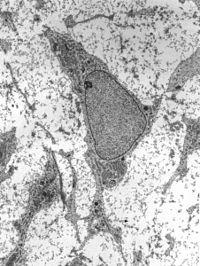
Photo from wikipedia
Summary Natural quantitative variation in developmental processes must be driven by allelic variation. Yet, the genotype-phenotype relationships underlying developmental system variation are understudied due to their inherent complexity. Taking advantage… Click to show full abstract
Summary Natural quantitative variation in developmental processes must be driven by allelic variation. Yet, the genotype-phenotype relationships underlying developmental system variation are understudied due to their inherent complexity. Taking advantage of the simple Caenorhabditis elegans germline stem cell system, we characterized natural differences in the germ stem cell niche activity of two distinct wild isolates—measured as differences in germline progenitor zone (PZ) size. Through quantitative trait locus (QTL) analysis, we detected multiple candidate causal loci, including two large-effect QTL on chromosomes II and V. Resolving the chromosome V QTL, we show that the isolate with a smaller PZ exhibits a unique 148 bp deletion in the promoter region of the Notch ligand, lag-2, a central signal promoting germ stem cell fate and proliferation. As predicted, introducing this deletion into the isolate with a large PZ resulted in a smaller PZ. Unexpectedly, re-introducing the deleted ancestral sequence in the isolate with a smaller PZ further reduced PZ size. Using allelic replacement lines, we show that these contradictory phenotypic effects are due to epistatic interactions among the lag-2 promoter, the chromosome II QTL, and additional loci in the genome. Although the lag-2 deletion appeared to explain natural variation in germ stem cell niche activity, its effects across multiple genetic backgrounds were unpredictable due to higher-order epistasis. Studying the genetic architecture of quantitative developmental systems without taking into account its natural variation may be misleading, emphasizing the need for a better integration of developmental and quantitative genetics.
Journal Title: Nature Communications
Year Published: 2022
Link to full text (if available)
Share on Social Media: Sign Up to like & get
recommendations!